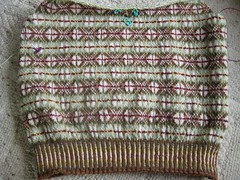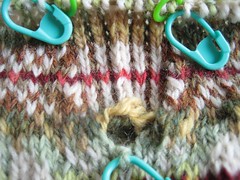I really ought to work on something else so that you can read about something besides this same garment post after post. But I’m all about sharin’ the love.
 I’m still enjoying working on this, which is the real reason nothing has distracted me. I was a little tempted by the Tamarix Quilt featured in the latest Interweave Knits magazine to land on my doorstep – I want to knit it for Jeff’s cousin who is expecting at the end of the year – but I really don’t want this vest to languish. So I queued Tamarix up in Ravelry, and got back to the vest.
I’m still enjoying working on this, which is the real reason nothing has distracted me. I was a little tempted by the Tamarix Quilt featured in the latest Interweave Knits magazine to land on my doorstep – I want to knit it for Jeff’s cousin who is expecting at the end of the year – but I really don’t want this vest to languish. So I queued Tamarix up in Ravelry, and got back to the vest.
I’m at the steeks now, which is exciting. There are three. One at the beginning of the round for the left arm, one at the front for the v-neck opening, and one for the right arm. The latter two are the ones that are well done. It’s the steek that occurs at the beginning and end of the round that’s giving me fits. Because it’s at the beginning of the round, it’s where the colors change – right in the middle of the 12-stitch steek. So things are a bit loosey-goosey. It doesn’t make sense to weave the colors in as I was doing earlier with the color changes, since this section will be cut. I’ve tried tying the new color to the old with a square knot, but more often than (k)not, the knot is pulling through the first stitch of the round. It started out okay, but it’s getting rapidly uglier. I, uh, didn’t take a picture of that steek.
 The next round I’m going to try just adding the new color, doing a bit of knitting, and then coming back to knot later. That way I can get the tension right before knotting. I probably shouldn’t be fretting about a section that’s going to be cut anyway, but since I plan to trust the physics of wool fiber rather than crocheting or sewing to reinforce the steek before cutting, I want things as neat and tidy as possible.
The next round I’m going to try just adding the new color, doing a bit of knitting, and then coming back to knot later. That way I can get the tension right before knotting. I probably shouldn’t be fretting about a section that’s going to be cut anyway, but since I plan to trust the physics of wool fiber rather than crocheting or sewing to reinforce the steek before cutting, I want things as neat and tidy as possible.
An interesting note that Ann Feitelson makes about the decreases: she instructs the knitter to always slant them toward the steek (or “extra stitches” as she calls them) rather than toward the knitted fabric. I’ve always done the opposite with decreases around neck and armholes in sweaters, and she notes that most American knitters do this. Feitelson points out that slanting toward the fabric actually exaggerates the edge of the fabric. Having followed her instructions, I can see her point. Clicking on the picture above will take you to the Flickr photo with notes showing which kinds of decreases I’m doing on each side of the steek.
I’m somewhere near row 100 of the 160 rounds I get to knit before shaping the neck. Over halfway there! The decreases are getting a bit strange and hard to track (at 4 places every 2 rounds 13 times and at 2 places every 3 rounds 21 times), but so far I’m keeping up.
Wow. That's about all I have to say - wow!
ReplyDeleteSteven - this is so amazing that I'm just sitting here staring at the picture! Thanks for taking us through your progress - I'm learning so much.
ReplyDelete